Digital Transformation Journey: a CTO’s Guide to Modernizing Legacy Systems
So what’s hampering the execution? In most cases, people, processes and legacy systems are among the top bottlenecks. According to Logicalis, 4 in 10 CIOs name “complex legacy technology” as the main roadblock to digital transformations. Lack of employee buy-in and cultural resistance are among frequently cited issues as well.
Indeed, when you lift the proverbial hood and take a peek at a modern enterprise, you see a complex, interwoven ecosystem of people, systems, infrastructure, applications and processes running round-the-clock. Assessing, understanding and decoupling those elements will be the first step a CTO in charge of digital transformations will have to take.
CTO’s Changing Role in The Digital Transformation Process
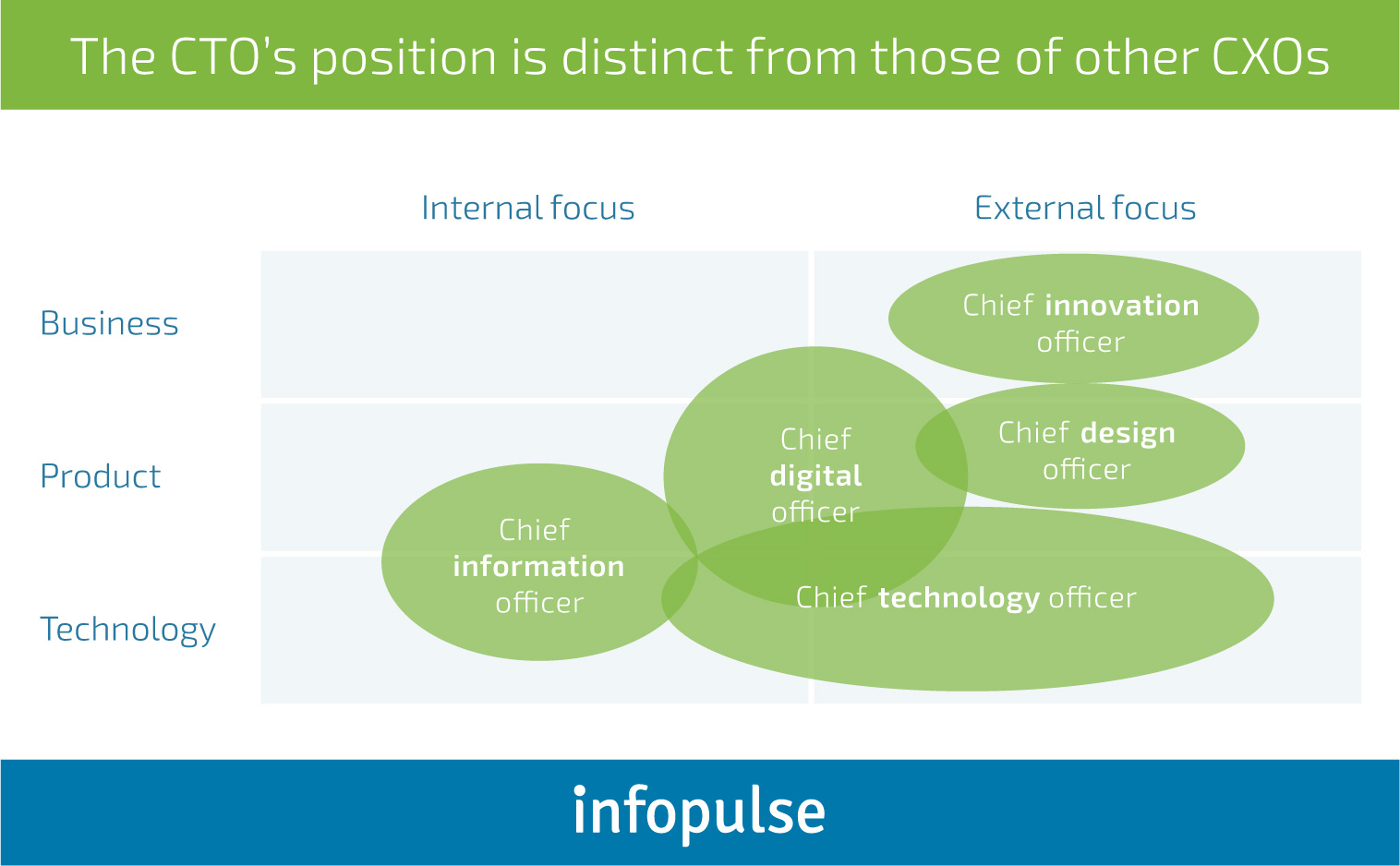
Within a number of organizations, CTOs are no longer just ‘technology officers’. Their role evolved into becoming Chief Transformation Officers with a host of new responsibilities beyond the standard scope.
CTOs are now responsible for:
- Identifying new technologies that are coming to the fore and how they will impact internal IT processes and external services delivery.
- Where the challenges and opportunities associated with them lie for the company (internal focus shared with CIO and a broader market outlook, aligned with the company’s business goals).
- Analyzing and formulating new business cases for modernization (internal and external focuses).
- Overseeing their successful execution and subsequent adoption of new technology by all personnel.
As McKinsey puts it: “The CTO is a high-level orchestrator of a complex process that involves large numbers of discrete initiatives. Responsibility for making the day-to-day decisions and implementing those initiatives lies with line managers, but the CTO’s job is to make sure the job is done.”
That’s not an easy task for sure, especially when the initiative at hand is legacy systems modernization.
Legacy System Modernization: 5 Key Challenges CTOs Face
1. Skills gap and subsequent organizational change management
De-tangling decade-old legacy systems and understanding their business logic will likely require professionals with niche skills. Lack or loss of software documentation adds additional complexity to the issue.
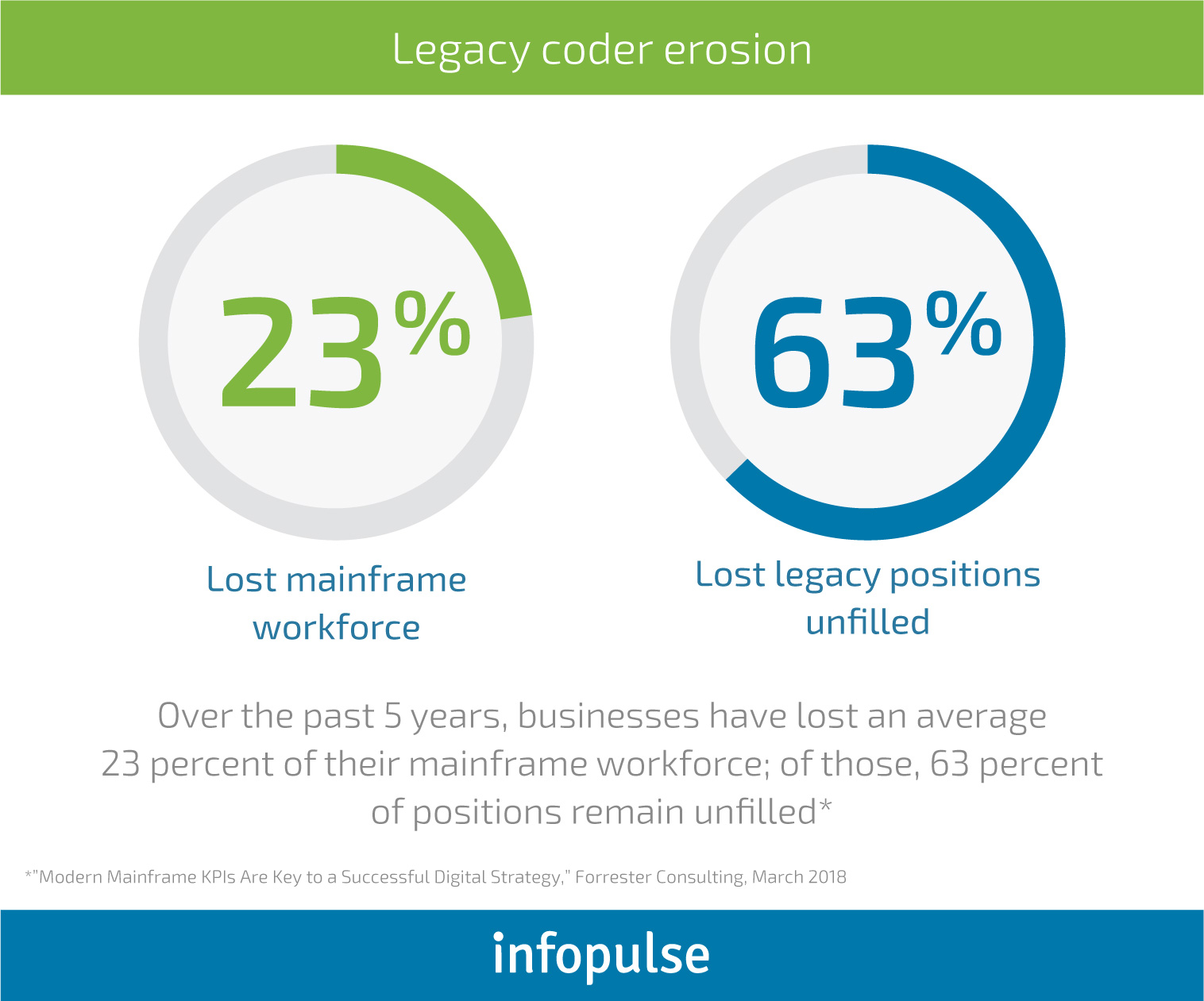
On the other hand, your further digital transformation journey will require hiring people with expertise in new technologies. Thus, during the transition period, you may find yourself constantly working on the people side of change management – creating and filling in new roles, establishing new reskilling- and training programs, and continuously educating your teams on the upcoming changes.
The effectiveness of your efforts will underpin the success of further technological changes.
2. Cultural resistance and low digital maturity
Business adoption and seamless technical execution may initially seem like the biggest challenges on the digital transformation journey. However, only 7.5% of executives point to ‘technology’ as an obstacle in the NewVantage Partners survey:
- 92.5% of the respondents name ‘people and processes’ as a major roadblock to successful execution.
- 40.3% state that lack of organizational alignment is slowing down the adoption of new tech.
- 24% cite cultural resistance as the leading factor contributing to slow modernization.
In most cases, low stakeholder and end-user engagement stem from modest digital literacy levels cross-organization. Indeed, the same survey indicates that the number of companies identifying themselves as data-driven decreased from 37.1% in 2017 to 31% in 2019. This decline signifies that a lot of businesses place the strongest focus on technology, not people, and forget that new tech can only be transformative in the right hands.
As a result, any modernization program should include the ‘human transformation’ element as well. As a CTO, you’ll need to work closely with the COO and HR executives to determine the scope of required digital competencies and staffing needs.
3. Modernization costs and long returns
Estimating the costs of a legacy application modernization is extremely hard, as they often come with loads of unknown dependencies, a hard-to-estimate timeline, and even more elusive ROI numbers.
To give you a ballpark rate, Gartner estimated that by the end of 2020, enterprises will have to match every dollar invested in digital transformations with at least $3 spent on modernizing their legacy application portfolio.
Deloitte survey of L&A insurers, which have recently completed core systems transformation initiatives, revealed that 46% of companies start seeing returns in 4+ years, as the infographic below suggests:
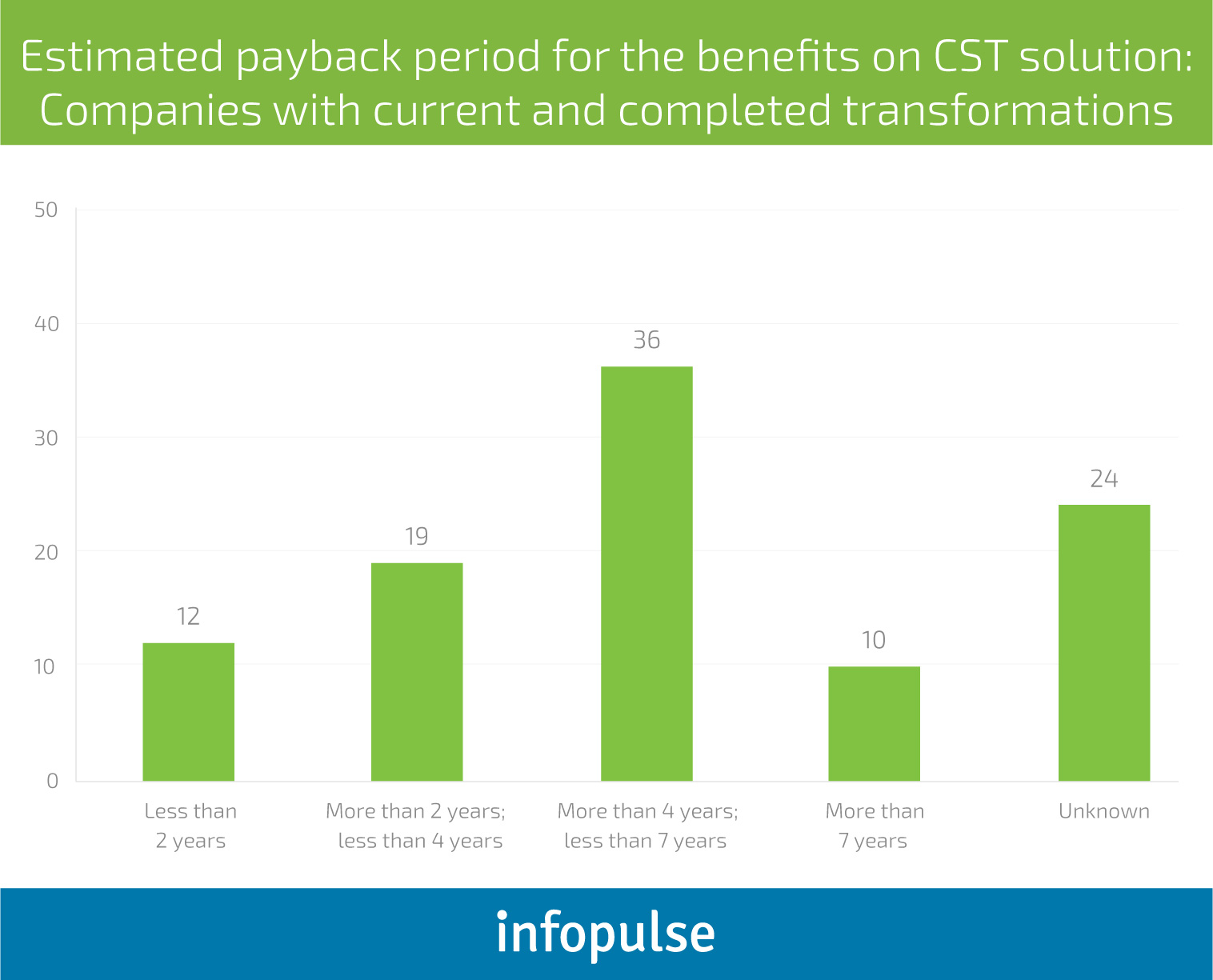
Yet, these are the CTOs who are required to justify legacy modernization. When the estimates are hard to make, your best bet is to appeal to the current costs of operating and maintaining the legacy IT infrastructure. On average, large enterprises spend up to 8 0% of their budgets on keeping the old, albeit ineffective, systems afloat. Thus, you will likely need to persuade the stakeholders that failure to modernize those outdated systems comes at a double cost:
- Bloated maintenance and overhead costs of maintaining the systems.
- Growth opportunities and revenue lost since most of them lack IT budget for innovation.
4. Balancing security and modernization
Legacy systems nearing the end-of-support date or merely those who ‘have already seen their best days’ are a huge security vulnerability. On the other hand, modernizing them and migrating them to the cloud (or a hybrid setup) increases heterogeneity, and increases the scope of required defense perimeter.
Newer approaches to cybersecurity are a must for successful and sustainable digital transformations. We provide a deeper take on the best strategies for that in our new eBook: “Innovative Security Approaches to Enable Digital Business Transformation ”.
5. Co-existence of Legacy and New Systems
A common step in any business transformation journey is orchestrating the final migration, and minimizing likely disruption and downtime. Enterprises may not be able to execute data migration in one rapid swipe or lift and shift new applications in a matter of hours. As a result, the transition period often ends up being stressful as CTOs need to ensure complete business coverage while dealing with a lot of side issues, e.g.:
- Ensure fully serviceable overlapping functionality.
- Deal with data duplication and avoid data loss.
- Introduce new systems in phases and migrate users in batches.
- Set up interim IT solutions to bridge the legacy and new systems, etc.
All of the above will require solid legacy system modernization strategies, as well as meticulous planning.
Six Legacy System Modernization Tips for a CTO
There’s no ‘one-size-fits-all’ approach to legacy system modernization. To choose the most optimal one, you’ll need to determine whether your current problems are caused by technology, architecture or the functionality of the application, and gauge how new technologies can solve those problems. To accomplish just that, we propose the following six best practices that work effectively cross-industry.
1. Formalize the Needs and Set Modernization Priorities
On the one hand, failure to modernize in a timely manner can sabotage your business growth. On the other, rushing with the decision to retire all legacy software and jump into a new IT solution isn’t wise either. After all, the journey to digital transformation is hard to gauge in terms of returns, costs and potential benefits. As a result, modernization ahead of the curve may not bring you the outcome you’ve expected, or worse – lead to failure.
Thus, it’s important to pace the decision and engage in a needs assessment first. Talk with different user groups and stakeholders to capture information about the following:
- Main business value the legacy system provides;
- Key business logics and interactions;
- Common issues and inefficiencies within the current system;
- Desired functionality that new IT stack can provide;
- The most utilized and underutilized parts of the system;
- Common limitations and glitches.
Your next step is to benchmark the identified gaps and issues with your legacy software against the costs and complexities of migrating to a new solution. Specifically, you’d want to determine if:
- You have fully maximized the cost savings opportunities of your legacy systems: rationalized application/software portfolio, optimized and negotiated pricing/licensing costs, replaced expensive products with lower-priced alternatives, etc.
- You have sufficient infrastructure to support modernization in terms of skills, operational robustness, and software/hardware.
- The cost of adopting a new solution indeed brings higher efficiency, lower risks, and significant cost savings.
Doing so will help you determine whether it makes sense to abandon your entire core platform right now, start modernizing only certain elements of your systems or add small localized changes to address specific issues.
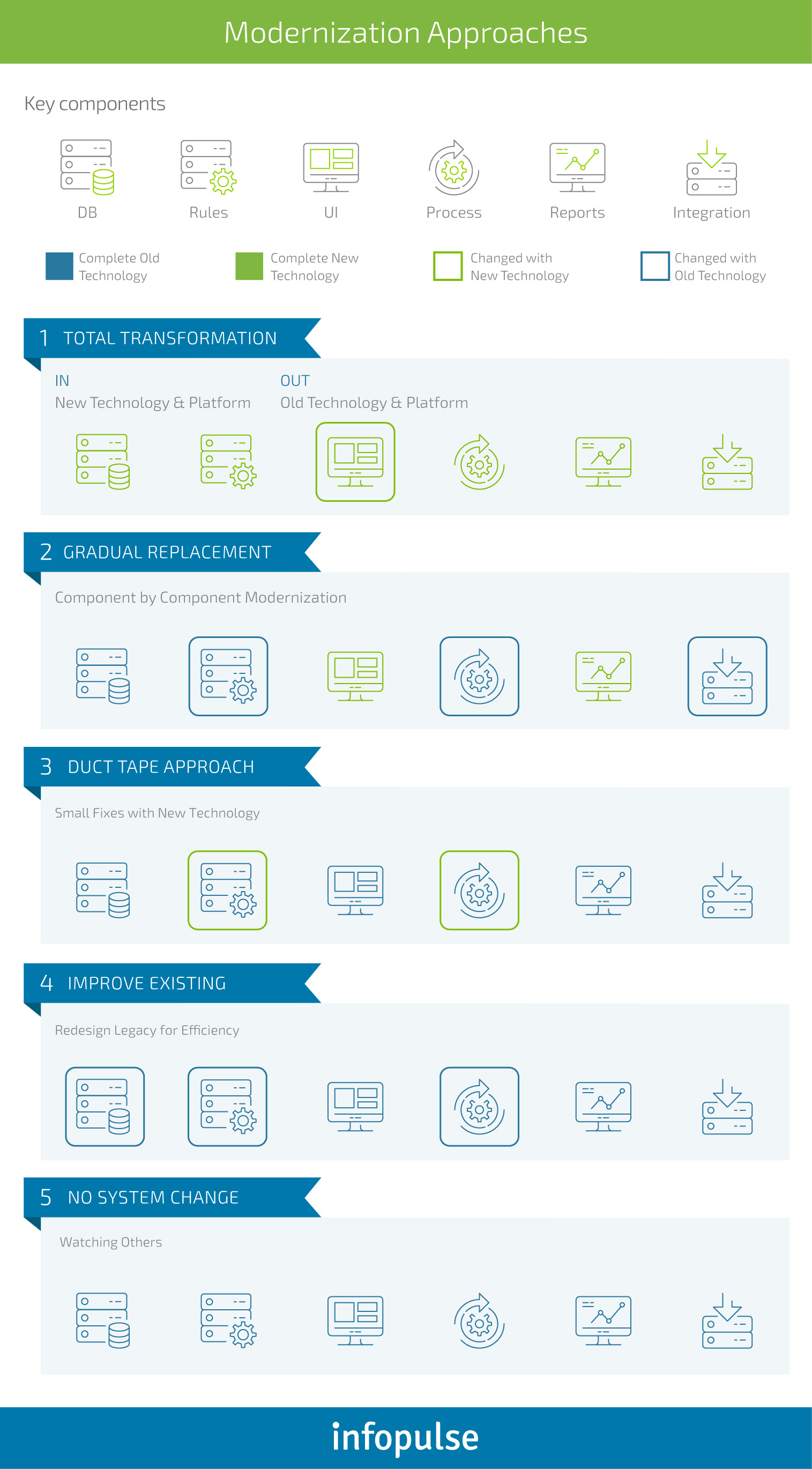
2. Perform Inventory of Assets
Most legacy systems were composed in a rush to meet ad hoc needs. As a result, they exist in a silo that needs to be understood and uncovered. Thus, conducting a thorough inventory should be among the first digital transformation journey steps you take.
Once you have formalized your needs and identified core areas for improvement, consider how you can incorporate those without bloating your IT stack even further. Some of the elegant and non-invasive solutions include:
- Introducing Service and Data access layers as middleware between a legacy system and a new application.
- Encapsulation of key data and functions in the application and subsequent transformation to services via APIs.
- Shift to microservices architecture.
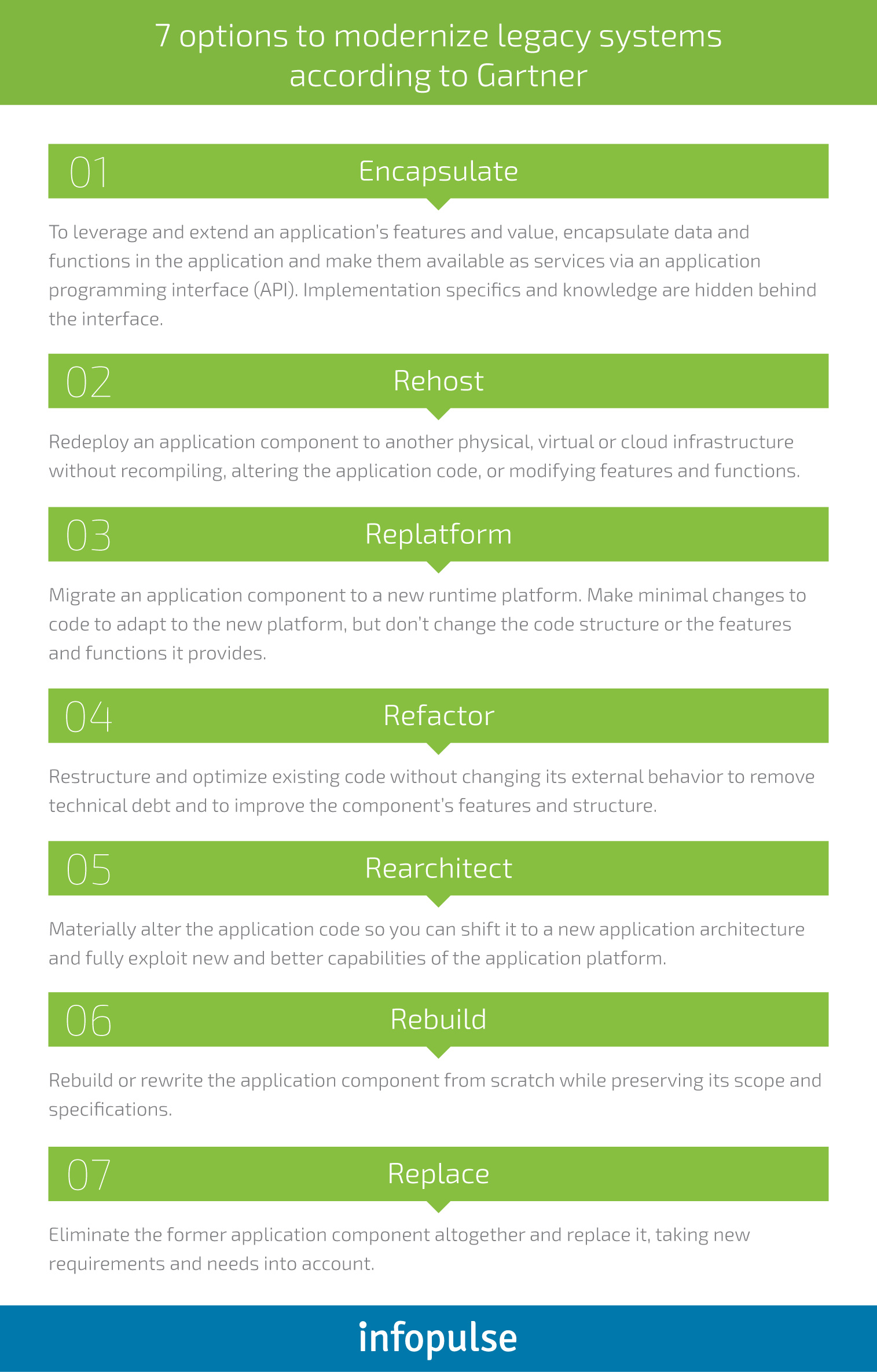
Don’t rush with executing either of the ‘re-’ approaches as those tend to come with the highest risks and costs. Instead, holistically assess how each of them will affect:
- You customers
- Your IT and DevOps teams
- Your estimated budgets
Try to guesstimate a timeline for each option, and conduct a quick SWOT analysis to better stack each option against each other.
4. Portability Should Be Your Top Priority
Monolith, waterfall applications are well past their prime. While it may be worth keeping certain elements of them up and running, by no means should you attempt to model your new systems after them.
Keep a strong focus on decoupling, and start your transition to software-defined infrastructure that will eventually enable complete portability across cloud environments, container tools, servers and storage options. This way you’ll eliminate the risks of vendor lock-in for good and gain immense agility.
5. Migrate to Modern Data Platforms
Data is the fuel of digital transformations. However, legacy systems and databases were never meant to support the current volume of data or emerging methods for operationalizing it. Adoption of new analytics solutions such as self-service BI, big data and predictive analytics, or even sophisticated AI-powered systems require modern data platforms.
In addition, with the adoption of the cloud, data is becoming too disparate for rigid legacy systems to handle. Legacy software often makes it hard (or even impossible) to hand-code data pipelines or effectively implement integrations. Thus, they often become a major roadblock to the company’s data-driven initiatives.
Another major issue is speed. Real-time data processing has become a ‘must’ for certain technology use cases. Even a 5-second lag can be critical. IDC estimates that by 2025, 10% of all data will become hypercritical – if such data is processed with even the slightest delay, the consequences can be grim. Think healthcare, self-driven vehicles or logistics. The legacy architecture was never meant to facilitate such rapid data exchanges.
Thus, modernization of legacy enterprise data architecture should be a key element in your overall initiative.
6. Make Plans for Future Growth
Don’t repeat the mistakes made with legacy software and create detailed software documentation early on. Specifically, create a detailed knowledge base that contains information on the new system:
- Requirements
- Architecture
- Source code
- Maintenance
- Quality assurance
- Support & training.
As the modernization process will span over several years and through several phases, create a set of KPIs that will help you assess the early successes and make more accurate estimates regarding the next steps. The basic reports should include information on the weekly application status, weekly top issues, deployment statuses, etc.
Lastly, it’s always worth having a clear failover strategy at hand in case any aspect of the modernization goes haywire. Even if you are progressing steadily and effectively, ensure that your team knows how to execute plan B.
Conclusions
Effective legacy modernization is a combination of careful planning, the right people and the right IT technology stack that collectively can transform your organization. As a CTO, your main goal is to work out the right balance between these elements. Start with a careful assessment of your current inventory to formalize the most pressing needs and map out the priorities. Consider the non-invasive approaches first, as these may bring more measurable ROI within a shorter period, and help obtain stakeholder buy-in for more complex transformations.
Infopulse team would be delighted to help you be even more successful in your role as CTO and step in as your technological and consulting arm. We will provide the talent to execute your ambitious project and optimize your costs. Our consultants can also help you formalize your goals, refine your transformation roadmap and craft a detailed list of requirements for the new solution that will give your business agility, speed and competitive edge for the digital economy era. Get in touch with us today!

![Pros and Cons of CEA [thumbnail]](/uploads/media/thumbnail-280x222-industrial-scale-of-controlled-agriEnvironment.webp)

![Power Platform for Manufacturing [Thumbnail]](/uploads/media/thumbnail-280x222-power-platform-for-manufacturing-companies-key-use-cases.webp)
![Agriculture Robotics Trends [Thumbnail]](/uploads/media/thumbnail-280x222-what-agricultural-robotics-trends-you-should-be-adopting-and-why.webp)
![ServiceNow & Generative AI [thumbnail]](/uploads/media/thumbnail-280x222-servicenow-and-ai.webp)

![Data Analytics and AI Use Cases in Finance [Thumbnail]](/uploads/media/thumbnail-280x222-combining-data-analytics-and-ai-in-finance-benefits-and-use-cases.webp)
![AI in Telecom [Thumbnail]](/uploads/media/thumbnail-280x222-ai-in-telecom-network-optimization.webp)

